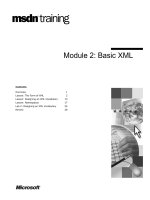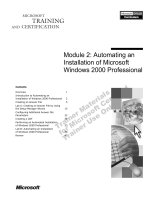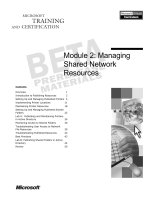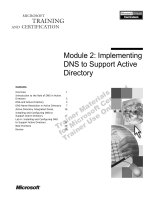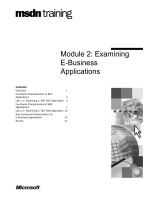Tài liệu Module 2: Troubleshooting Remote Procedure Call (RPC) Over HTTP pptx
Bạn đang xem bản rút gọn của tài liệu. Xem và tải ngay bản đầy đủ của tài liệu tại đây (1.04 MB, 41 trang )
`
Module 2:
Troubleshooting
Remote Procedure Call
(RPC) Over HTTP
Contents
Introducing RPC over HTTP ..................................................1
Pre-Requisites for RPC/HTTP ...............................................6
RPC over HTTP Setup..............................................................8
Using RpcHttp_Setup.vbs.................................................... 10
The RPC Virtual Directory in IIS .......................................16
Troubleshooting Server Configuration............................18
Client Registry Keys ..............................................................19
Troubleshooting Client-Server Connectivity ................ 21
Certificates and client problems ....................................... 27
Troubleshooting with RPCPing...........................................28
Lab 2.1: Troubleshooting RPC over HTTP.....................33
Appendix A - RPCPing ............................................ 35
Appendix B – Registry Values.......................... 38
Appendix C – Useful Weblinks......................... 39
Information in this document, including URL and other Internet Web site references, is subject to
change without notice. Unless otherwise noted, the example companies, organizations, products,
domain names, e-mail addresses, logos, people, places, and events depicted herein are fictitious,
and no association with any real company, organization, product, domain name, e-mail address,
logo, person, place or event is intended or should be inferred. Complying with all applicable
copyright laws is the responsibility of the user. Without limiting the rights under copyright, no
part of this document may be reproduced, stored in or introduced into a retrieval system, or
transmitted in any form or by any means (electronic, mechanical, photocopying, recording, or
otherwise), or for any purpose, without the express written permission of Microsoft Corporation.
Microsoft may have patents, patent applications, trademarks, copyrights, or other intellectual
property rights covering subject matter in this document. Except as expressly provided in any
written license agreement from Microsoft, the furnishing of this document does not give you any
license to these patents, trademarks, copyrights, or other intellectual property.
2003 Microsoft Corporation. All rights reserved.
Microsoft, MS-DOS, Windows, Windows NT, Microsoft® Exchange Server 2003, Microsoft®
Internet Explorer, Microsoft® Internet Security and Acceleration Server, Microsoft® Internet
Server Application Programming Interface, Microsoft® Outlook® 2003, Microsoft® Proxy
Server, Microsoft® Windows® 2000, Microsoft® Windows® 2003, Microsoft® Windows®
Management Instrumentation, and Microsoft® Windows® XP are either registered trademarks or
trademarks of Microsoft Corporation in the United States and/or other countries.
The names of actual companies and products mentioned herein may be the trademarks of their
respective owners.
Module 2: Troubleshooting Remote Procedure Call (RPC) Over HTTP 1
Introducing RPC over HTTP
RPC over HTTP enables client programs to use the Internet to execute
procedures provided by server programs on distant networks. RPC over HTTP
tunnels its calls through an established HTTP port. Thus, its calls can cross
network firewalls on both the client and server networks.
RPC over HTTP routes its calls to the RPCProxy located on the RPC server's
network. The RPCProxy establishes and maintains a connection to the RPC
server. It serves as a proxy, dispatching remote procedure calls to the RPC
server and sending the server's replies back across the Internet to the client
application. This process is illustrated in the following diagram.
2 Module 2: Troubleshooting Remote Procedure Call (RPC) Over HTTP
The diagram shows a firewall on the client application's network. This is not
required for RPC over HTTP to operate. However, if the client network does
have a firewall, it will also need a proxy server program such as Microsoft®
Proxy Server.
When the client program issues a remote procedure call using HTTP as the
transport, the RPC run-time library on the client contacts the RPCProxy.
Depending on whether the RPC client was asked to use HTTP or HTTPS
(HTTP with Secure Sockets Layer [SSL]) port 80 or port 443 is used,
respectively. The RPCProxy contacts the RPC server program and establishes a
TCP/IP connection. The client and the RPCProxy maintain their HTTP or
HTTPS connection across the Internet.
The client's HTTP or HTTPS connection to the RPCProxy can pass through a
firewall (subject to appropriate access permissions) if one is present. The server
can then execute the remote procedure call and use the connection through the
RPCProxy to reply to the client. The RPCProxy is a Microsoft® Internet Server
Application Programming Interface (ISAPI) extension running in the context of
Microsoft Internet Information Services (IIS).
If either the client or the server disconnects for any reason, the RPCProxy will
detect it and end the RPC session. As long as the session continues, the
RPCProxy will maintain its connections to the client and the server. It will
forward remote procedure calls from the client to the server, and send replies
from the server to the client.
The RPC client program can tunnel its RPC calls through the Internet by
creating a string binding of the form:
Module 2: Troubleshooting Remote Procedure Call (RPC) Over HTTP 3
[object_uuid@]ncacn_http:rpc_server[endpoint,HttpProxy=proxy_s
erver:http_port,’rpcproxy’=rpc_proxy:rpc_port]
Where:
object_uuid specifies an RPC object UUID. For more information, see
Generating Interface UUIDs
and
String UUID
.
ncacn_http selects the protocol sequence specification for RPC over HTTP.
For more information, see
Protocol Sequence Constants
and
String
Binding
.
rpc_server is the network address of the computer that is executing the
RPC server process. The server address must be specified in a form visible
and understandable by the RPCProxy computer, not by the client. Since the
client does not connect directly to the server, it does not need to be able to
resolve the name of the server, or establish a connection to it. The
RPCProxy will establish the connection on the client’s behalf, and therefore,
rpc_server must be a name recognizable by the RPCProxy.
endpoint specifies the TCP/IP port that the RPC server process listens to for
remote procedure calls. For more information, see
Finding Endpoints
.
HttpProxy optionally specifies an HTTP proxy server on the RPC client's
network, such as Microsoft Proxy Server. If a proxy server is selected, no
port number is specified, the RPC stub uses port 80 by default if SSL is not
requested, and port 443 if SSL is specified.
RPCProxy specifies the address and port number of the IIS computer that
acts as a proxy to the RPC server. You only need to specify this if the RPC
server process resides on a different computer than the RPCProxy. If you do
not specify a port number, the RPC client stub by default uses port 80 if
SSL is not specified, and uses port 443 is SSL (HTTPS) is specified.
For more information on creating string bindings, see
Binding and Handles
.
The RPC server program can accept tunneled RPC calls by listening on the
ncacn_http protocol sequence.
Microsoft has two major implementations of RPC over HTTP: Version 1 and
Version 2.
Version 1 (called RPC over HTTP v1) is supported through Microsoft®
Windows® XP. Version 1 of the RPCProxy is supported through
Microsoft® Windows® 2000.
Version 2 (called RPC over HTTP v2) is the current version.
The two versions have different capabilities and limited interoperability. A
summary of the differences is provided here. For interoperability
considerations, see
System Requirements and Interoperability for RPC
over HTTP
.
RPC over HTTP v1 requires SSL Tunneling to be enabled on all HTTP
proxies/firewalls between the RPC over HTTP client and the RPCProxy. RPC
over HTTP v2 has no such requirement.
RPC over HTTP v1 cannot establish an SSL session to the RPCProxy. The RPC
over HTTP v2 can send all RPC over HTTP traffic within an SSL session; by
default v2 requires the data be sent within an SSL session.
Versions
4 Module 2: Troubleshooting Remote Procedure Call (RPC) Over HTTP
RPC over HTTP v1 cannot authenticate to the RPCProxy. RPC over HTTP v2
can authenticate; by default v2 requires authentication to the RPCProxy.
RPCProxy v1 does not operate correctly when the IIS machine on which it is
installed is part of a web farm. RPCProxy v2 operates properly when the IIS
machine on which it is installed is part of a web farm.
If Microsoft® Internet Explorer is installed on the client program's
computer and your client does not specify an HttpProxy in its string binding,
the RPC client stub will search the registry on the client computer for an
HttpProxy entry. If it finds one, it will use the proxy specified in the registry
entry.
Suppose, for instance, your client program needs to connect across the Internet
to an RPC server on a computer called Server7.microsoft.com. Further, suppose
that the RPCProxy runs on Major7.microsoft.com. The RPC server program
listens to port 2225. Your client would use the string binding:
ncacn_http:Server7.microsoft.com[2225,
‘rpcproxy’=Major7.microsoft.com]
If the RPCProxy can resolve the server name as Server7, without requiring a
fully qualified domain name, you can also specify:
ncacn_http:Server7 [2225, ‘rpcproxy’=Major7.microsoft.com]
If the client network uses a firewall and an Internet proxy server called
myproxy, and Internet Explorer on the client is not configured to use that proxy,
you would need to modify the client's string binding to:
ncacn_http:Server7.microsoft.com[,HttpProxy=myproxy:80,’rpcpro
xy’=Major7.microsoft.com:80]
This directs the client to connect to the RPC server program on
Server7.microsoft.com. To do this, the client will first use port 80 (or port 443
if SSL is used) to connect to myproxy. This will give the client program access
to the Internet. Using the Internet, the client program next connects to the
RPCProxy on Major7.microsoft.com. The RPCProxy will establish a
connection to the RPC server program running on Server7.microsoft.com.
The vast majority of computers today are configured for Web browsing.
Therefore, most clients do not need to specify the HttpProxy, because it will be
pulled from Internet connectivity settings.
The following subjects will be examined as well as methods to successfully
determine the fault(s) if it does not work as expected.
1. Prerequisites required for successful deployment
2. Installation and configuration of the RPCProxy Server Service
3. Configuration of the Exchange 2003 Server components
4. Deploying RPC over HTTP with Microsoft® Internet Security and
Acceleration Server (ISA) Server
5. Using RPCPing to identify source of the problem(s)
Note
Module 2: Troubleshooting Remote Procedure Call (RPC) Over HTTP 5
6 Module 2: Troubleshooting Remote Procedure Call (RPC) Over HTTP
Pre-Requisites for RPC/HTTP
Client-side
Microsoft® Outlook® 2003
Windows XP with Service Pack 1 + Q331320
RPC over HTTP requires the
QFE
referenced in Q331320 installed on the client
workstation. This fix will be included in Windows XP SERVICE PACK 2.
Ensure %windir%\system32\RPCRT4.DLL is 5.1.2600.1142 or above. This
and later builds addresses an apparent delay in the client. This problem is more
noticeable when connecting via a slow network link and the "Bypass proxy
server for local addresses" check box is selected in the Microsoft Internet
Explorer options and the HTTP connection to Microsoft® Exchange Server
2003 can be made through the HTTP proxy server on the network to which you
are connected. Outlook 2003 has issued a local RPC call that is waiting for a
remote RPC call to complete.
After installing the fix the client will need to be rebooted.
Server-side
Exchange 2003 on Microsoft® Windows® 2003 for FE (if FE is deployed)
Exchange 2003 on Windows 2003 for BE
Exchange 2003 on Windows 2003 for Public Folders
Exchange 2003 on Windows 2003 for System Folders
Windows 2003 for global catalog server(s)
Windows 2003 for RPCProxy.
Note
Module 2: Troubleshooting Remote Procedure Call (RPC) Over HTTP 7
The NSPI interface protocol sequences parameter needs to be added to the
registry on ALL Windows 2003 global catalogs. This is a manual entry not
configured by RpcHttp_Setup.vbs; the contents of the correct .reg file are
included in Appendix B.
8 Module 2: Troubleshooting Remote Procedure Call (RPC) Over HTTP
RPC over HTTP Setup
The RPCProxy server, the server with the RPCProxy protocol installed, must be
a Windows 2003 server. However, it does not have to have any Exchange
components installed. Many will choose to have their front-end servers act as
the RPCProxy server because this will eliminate hardware and administrative
costs. The RPCProxy protocol will work installed on an ISA server as well.
Exchange 2003 server adds the following registry entries to every Windows
2003 server on which it is installed. These registry entries determine the ports
that RPCProxy will use. The installation sets a fixed port for the protocol and
this reduces security risks with regard to TCP port control.
HKEY_LOCAL_MACHINE\System\CurrentControlSet\Services\MSExchang
eIS\ParametersSystem
Parameter: Rpc/HTTP Port
Type: REG_DWORD
Value: 0x1771 (Decimal: 6001)
And then for the System Attendant:
HKEY_LOCAL_MACHINE\System\CurrentControlSet\Services\MSExchang
eSA\Parameters
Parameter: Rpc/HTTP NSPI Port
Type: REG_DWORD
Value: 0x1774 (Decimal: 6004)
Exchange Server
Registry
Module 2: Troubleshooting Remote Procedure Call (RPC) Over HTTP 9
HKEY_LOCAL_MACHINE\System\CurrentControlSet\Services\MSExchang
eSA\Parameters
Parameter: HTTP Port
Type: REG_DWORD
Value: 0x1772 (Decimal: 6002)
The registry setting for Windows 2003 global catalog servers is not automated
by Exchange 2003 setup. This setting must be configured either manually or
programmatically for RPC over HTTP to work. This is scheduled to be
included in Windows 2003 Service Pack 1 (SP1).
HKEY_LOCAL_MACHINE\System\CurrentControlSet\Services\NTDS\Para
meters
Parameter: NSPI interface protocol sequences
Type: REG_MULTI_SZ
Value: ncacn_http:6004
The RPC/HTTP Proxy server(s) must have the following registry entry to
communicate with the Exchange 2003 server and the Windows 2003 global
catalog(s).
HKEY_LOCAL_MACHINE\Software\Microsoft\Rpc\’rpcproxy’
Parameter: ValidPorts
Type: REG_SZ
The string data in this registry value should contain all the Window 2003
global catalogs and Exchange 2003 in the Exchange Organization. This key
can be configured manually, but the RpcHttp_Setup.vbs utility will configure
this value for every Exchange 2003 server installed on Windows 2003 server
and every Windows 2003 global catalog server. The contents of the registry
key should be similar to the one below.
Windows Registry Editor Version 5.00
[HKEY_LOCAL_MACHINE\SOFTWARE\Microsoft\Rpc\’rpcproxy’]
"Enabled"=dword:00000001
"ValidPorts"="Back-End:593;Back-End.concsi.lab:593;Back-
End:6001;Back-End.concsi.lab:6001;Back-End:6002;Back-
End.concsi.lab:6002;Back-End:6004;Back-
End.concsi.lab:6004;GC:593;GC.concsi.lab:593;GC:6004;GC.concsi
.lab:6004"
We highly recommend you use the setup script to configure the ‘rpcproxy
server’ and then remove any global catalog servers that should not be included
in the RPCProxy topology.
Global Catalo
g Registry
RPCProxy Server
Re
gistry
10 Module 2: Troubleshooting Remote Procedure Call (RPC) Over HTTP
Using RpcHttp_Setup.vbs
RpcHttp_Setup.vbs is part of the Web Release of Exchange 2003 tools and
utilities. Running the script from the command line with no options displays
the utility help.
C:\cscript RpcHttp_Setup.vbs
Microsoft (R) Windows Script Host Version 5.6 Copyright (C)
Microsoft Corporation 1996-2001. All rights reserved. --
RpcHttp_Setup.vbs (6.5.6889.0) –
Usage: RpcHttp_Setup.vbs -d:domainname (-i:importfile | -
r:front_end_proxy) [-p]
-d:domainname
Specify the domain name that you wish to search for Exchange and global
catalog servers. Your domain name should be a DNS fully qualified domain
name (FQDN) for the Active Directory domain. (Required parameter.)
-p (Do not allow access to RPC Portmapper port (593) via RPC/HTTP.)
-- At least one of the following two options must be
specified! --
-i:importfile
Specify a path where a registry import file will be created. The path should
include the file name. If the path contains spaces, it should be contained in
quotes. (Required parameter, unless -r is used.)
-r:front_end_proxy
Module 2: Troubleshooting Remote Procedure Call (RPC) Over HTTP 11
Specify the name of an RPCProxy server that will be updated remotely. The
script will automatically update the ValidPorts key on the remote server to
reflect the discovered topology.
(Required parameter, unless -i is used)
The registry entry for global catalog servers:
HKEY_LOCAL_MACHINE\System\CurrentControlSet\Services\NTDS\Para
meters
Parameter: NSPI interface protocol sequences
Type: REG_MULTI_SZ
Value: ncacn_http:6004
should be added prior to running the rpchttp_setup script as the script does not
configure the global catalog severs. Running the following command line prior
to doing so will result in the warning in the output below; WARNING “NSPI
port is not set in registry for global catalog server.”
cscript RpcHttp_Setup.vbs –d:domain_fqdn –
r:’rpcproxy’Server_fqdn
Microsoft (R) Windows Script Host Version 5.6
Copyright (C) Microsoft Corporation 1996-2001. All rights
reserved.
--- Detecting Exchange servers in 'De.mo'
--- Evaluating Exchange server E2k3-LegacyOS
--- Evaluating Exchange server ExchangeServer55
WARNING: Unable to determine Windows build number for
'ExchangeServer55.De.mo' using WMI. Assuming that it is not
running a Windows Server 2003 build. (Error: 462)
--- Evaluating Exchange server 'Exchange_Back-End'
--- Found 4 Exchange servers.
--- Skipped 2 Exchange servers without Windows Server 2003 (or
unavailable Windows version)
--- Skipped 1 Exchange servers of the wrong type (i.e. front-
end, IM, etc.)
--- Detecting AD Global Catalog servers in 'De.mo'
--- Evaluating Global Catalog server 'GlobalCatalogueServer'
WARNING: NSPI port is not set in registry for Global Catalog
server 'GlobalCatalogueServer.De.mo'. Using default port
range (1024-65535). Please fix this problem to improve
security.
--- Evaluating Global Catalog server E2k3-LegacyOS
--- Found 2 AD Global Catalog servers.
--- Skipped 1 AD Global Catalog servers without Windows Server
2003 (or unavailable Windows version)
--- Updating registry on ‘rpcproxy’ front-end
'GlobalCatalogueServer.de.mo'
--- All done!
12 Module 2: Troubleshooting Remote Procedure Call (RPC) Over HTTP
Multiple RPCProxy servers can be configured by appending:
“-r:other_’rpcproxy’Sever_fqdn” to the previous command line. The exact
number of “-r:” arguments has not been determined.
The utility will query the Active Directory and subsequently query all
Exchange Servers and global catalogs in the entire organisation to make sure
that only Exchange 2003 and Windows 2003 global catalogs are written into the
RPCProxy\ValidPorts key.
The majority of the output is self explanatory; however the warning that is
displayed regarding the global catalog requires some explanation.
--- Evaluating Global Catalog server 'GlobalCatalogueServer'
WARNING: NSPI port is not set in registry for Global Catalog
server 'GlobalCatalogueServer.de.mo'. Using default port
range (1024-65535). Please fix this problem to improve
security.
The warning indicates that the required registry parameter, seen below, for the
global catalog server, GlobalCatalogueServer, has not been configured.
HKLM\System\CurrentControlSet\Services\NTDS\Parameters\NSPI
interface protocol sequence
The value should be set to 6004 (0x1774). Examining the data entered into the
RPCProxy\ValidPorts key confirms that the global catalog port has not been set
to the required fixed value.
Exchange_Back-End:593;Exchange_Back-
End.De.mo:593;Exchange_Back-End:6001;Exchange_Back-
End.De.mo:6001;Exchange_Back-End:6002;Exchange_Back-
End.De.mo:6002;Exchange_Back-End:6004;Exchange_Back-
End.De.mo:6004;GlobalCatalogueServer:593;GlobalCatalogueServer
.De.mo:593;GlobalCatalogueServer:1024-
65535;GlobalCatalogueServer.De.mo:1024-65535
GlobalCatalogueServer is also a Windows 2003 global catalog.
This warning is removed by configuring the global catalog server(s) prior to
running the rpchttp_setup script. The registry import file can be found in
Appendix B. The output below is produced when the setup script is run after
configuring the global catalog server(s).
Exchange_Back-End:593;Exchange_Back-
End.De.mo:593;Exchange_Back-End:6001;Exchange_Back-
End.De.mo:6001;Exchange_Back-End:6002;Exchange_Back-
End.De.mo:6002;Exchange_Back-End:6004;Exchange_Back-
End.De.mo:6004;GlobalCatalogueServer:593;GlobalCatalogueServer
.De.mo:593;GlobalCatalogueServer:6004;GlobalCatalogueServer.De
.mo:6004
Note
Note
Module 2: Troubleshooting Remote Procedure Call (RPC) Over HTTP 13
Remember, only Exchange 2003 mailbox or Public Folder servers running on
Windows 2003 and Windows 2003 global catalog servers will be listed in the
Valid Ports registry value on the RPCProxy server.
It is possible to run the following command line which will give you a debug
output of the functions the utility goes through. You may want to run the utility
with this switch if all Windows 2003 global catalogs and Exchange 2003
servers running on Windows 2003 are not listed in the ValidPorts key.
CSCRIPT RpcHttp_Setup.vbs –d:YourDomain.Com –
r:Your’rpcproxy’.com -t
The beginning of the output will look similar to the following:
11/03/2003 11:01:57 - configurationNamingContext:
CN=Configuration,DC=Company,DC=com
11/03/2003 11:01:58 - Detecting Exchange servers...
--- Detecting Exchange servers in 'de.mo'
11/03/2003 11:01:58 – Exchange config DN: CN=Microsoft
Exchange,CN=Services,CN=Configuration,DC=Company,DC=com
11/03/2003 11:01:58 –
oADOcomm.CommandText: select cn, distinguishedName,
serverRole, networkAddress, heuristics FROM 'LDAP://De.mo
/CN=Microsoft
Exchange,CN=Services,CN=Configuration,DC=Company,DC=com' where
objectClass = 'msExchExchangeServer'
The emphasized text in the example above show what data is read and from
where in the Active Directory.
When the –t switch is set, the utility provides verbose output for each Exchange
Server queried. The following output is generated when the utility queried an
Exchange 2003 Server running on Windows 2000 SP3 called EX2k3-server.
The sections highlighted in bold illustrate what checks are made.
11/03/2003 11:02:00 - Detected exchange server: E2k3-LegacyOS
11/03/2003 11:02:00 - NetBIOS address: EX2K3-SERVER
11/03/2003 11:02:00 - dns address: EX2k3-server.De.mo
--- Evaluating Exchange server E2k3-LegacyOS
11/03/2003 11:02:00 - FIsWindowsNetBuild - INFO: Entering
GetObject for EX2k3-server.De.mo
11/03/2003 11:02:01 - FIsWindowsNetBuild - INFO: Leaving
GetObject for EX2k3-server.De.mo
11/03/2003 11:02:01 - FIsWindowsNetBuild - INFO: Entering
ExecQuery for EX2k3-server.De.mo
11/03/2003 11:02:01 - FIsWindowsNetBuild - INFO: Leaving
ExecQuery for EX2k3-server.De.mo
11/03/2003 11:02:01 - FIsWindowsNetBuild - 'EX2k3-
server.De.mo' BuildNumber=2195; Version=5.0.2195
11/03/2003 11:02:01 - CheckServerConfig - ignoring server '
EX2k3-server.De.mo (old windows build)
The output below is indicative of an Exchange 2003 server running on
Windows 2003.
Troubleshooting
RpcHttp_Setup.vbs
14 Module 2: Troubleshooting Remote Procedure Call (RPC) Over HTTP
11/03/2003 11:02:01 - Detected exchange server:
'Exchange_Back-End'
11/03/2003 11:02:01 - NetBIOS address: Exchange_Back-End
11/03/2003 11:02:01 - dns address: Exchange_Back-End.De.mo
--- Evaluating Exchange server E2k3-LegacyOS
11/03/2003 11:02:01 - FIsWindowsNetBuild - INFO: Entering
GetObject for Exchange_Back-End.De.mo
11/03/2003 11:02:01 - FIsWindowsNetBuild - INFO: Leaving
GetObject for Exchange_Back-End.De.mo
11/03/2003 11:02:01 - FIsWindowsNetBuild - INFO: Entering
ExecQuery for Exchange_Back-End.De.mo
11/03/2003 11:02:02 - FIsWindowsNetBuild - INFO: Leaving
ExecQuery for Exchange_Back-End.De.mo
11/03/2003 11:02:02 - FIsWindowsNetBuild – ‘Exchange_Back-
End.De.mo’ BuildNumber=3777; Version=5.2.3777
11/03/2003 11:02:02 - CheckServerConfig - Store port on
‘Exchange_Back-End.De.mo’ = 6001
11/03/2003 11:02:02 - CheckServerConfig - DS referral port on
' Exchange_Back-End.De.mo‘ = 6002
11/03/2003 11:02:02 - CheckServerConfig - DS proxy port on
‘Exchange_Back-End.De.mo ‘ = 6004
At the end of the debug output, the data that will be added to the ValidPorts
registry key will be shown:
--- Skipped 1 AD Global Catalog servers without Windows Server
2003 (or unavailable Windows version)
11/03/2003 14:53:50 - server count = 5
11/03/2003 14:53:50 - servers written to regkey = 2
11/03/2003 14:53:50 - sReg =
Exchange_Back-End:593;Exchange_Back-
End.De.mo:593;Exchange_Back-End:6001;Exchange_Back-
End.De.mo:6001;Exchange_Back-End:6002;Exchange_Back-
End.De.mo:6002;Exchange_Back-End:6004;Exchange_Back-
End.De.mo:6004;GlobalCatalogueServer:593;GlobalCatalogueServer
.De.mo:593;GlobalCatalogueServer:6004;GlobalCatalogueServer.De
.mo:6004
--- Updating registry on ‘rpcproxy’ front-end
'GlobalCatalogueServer.De.mo'
11/03/2003 14:53:50 - FUpdateRegistry - INFO: Entering
GetObject for GlobalCatalogueServer.De.mo
11/03/2003 14:53:50 - FUpdateRegistry - INFO: Leaving
GetObject for GlobalCatalogueServer.De.mo
--- All done!



